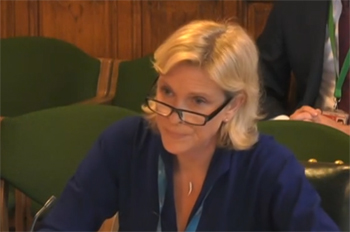Roads minister Baroness Vere delayed handing crucial reports on smart motorway schemes to MPs while her officials discussed with National Highways how to ‘pitch’ the findings, securing multiple changes to the documents, Transport Network can reveal.
After Baroness Vere was pressed by MPs on the Transport Select Committee on 30 June to release crucial documents detailing the performance of individual smart motorway schemes, her office held a meeting with National Highways, (then Highways England) officials to discuss changing the reports.

Baroness Vere appearing before MPs in June
Department for Transport (DfT) officials followed up by email on 12 July, asking if the 'final version' of the M1 junctions 10-13 report was ready and if it had been 'updated following the meeting'.
A subsequent email exchange reveals the report was amended after the meeting.
This report, finally published last month, revealed that journey times on the scheme had increased, costing the economy around £225m instead of the £1bn boost to the economy originally predicted.
Emails disclosed by the DfT under the Freedom of Information Act show that throughout July its officials held meetings with National Highways colleagues, discussed the draft documents by telephone and requested changes by email, with the drafts seemingly amended on each occasion.
A back and forth email chain details how the DfT questioned the 'tone' of the initial report's foreword and whether the report's claims were consistent.
A DfT official wrote: 'It states that the POPE shows that "all schemes are, at least partially, meeting their overall objectives". Is this consistent with paragraph eight of the covering submission which says that average journey times have increased.'
The existence of the reports was first disclosed by Transport Network's sister publication, Highways, in the spring. Transport Select Committee chair Huw Merriman MP then asked to see the reports and on 30 June roads minister Baroness Vere told a hearing of the committee that she would send them to him in around two weeks.
On 21 July the DfT stated that National Highways had finalised the reports and that they were with ministers for sign-off, ‘as is standard process’. It subsequently admitted that this was not standard, but was ‘a ministerial prerogative’.
A series of emails from 26 July had the subject line ‘Cluster/POPE reports comms handling’, and show the department requesting and achieving further changes to the reports. These emails request multiple changes to the documents' forewords.
In an email dated 28 July, a DfT official thanked National Highways ‘for the forwards (sic) which we think look much better’.
On 2 August, a DfT official thanked the National Highways official for new drafts of the reports, stating: ‘[The minister’s] private office has asked me to pass on their thanks too and say the foreword is better pitched.’
Transport Network made a request to National Highways for any drafts of the final version provided to the DfT prior to publication. It has not so far disclosed these drafts.
Making the case
The report into the M1 junctions 10-13 includes a significant quantity of ‘qualitative’ narrative, which downplays the quantitative finding that journey times had increased and journey time benefits were negative to the tune of nearly a quarter of a billion pounds.
This includes a claim that ‘without the additional capacity of the fourth lane it is unlikely that the existing three-lane motorway would have been able to support the increased number of road users, leading to even slower journeys, and congestion’.
The report’s summary also suggests that ‘in this case, the monetisation of journey time benefit is not a good measure of value for money and the qualitative evidence presented in the evaluation is considered a more robust measure’.
It also includes a claim that the Government’s policy of converting dynamic hard shoulder schemes, as in the scheme in question, to all lane running ‘is anticipated to unlock journey saving benefits for the M1 junction 10 to 13 and provide further value to the scheme’.
It is not clear what this is based on. However, the claim also appears in the foreword, suggesting it was considered important in setting a positive tone for what was in fact a negative evaluation.
Register now for full access
Register just once to get unrestricted, real-time coverage of the issues and challenges facing UK transport and highways engineers.
Full website content includes the latest news, exclusive commentary from leading industry figures and detailed topical analysis of the highways, transportation, environment and place-shaping sectors.
Use the link below to register your details for full, free access.
Already a registered? Login